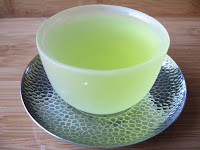I recently got some Tencha, but did not really know how to brew it so I decided to experiment with it somewhat. Tencha for those who don't know is the unground tea leaves used for matcha. So in theory if you were to grind these leaves up you would make your own matcha.
The method I used for brewing my experiment consisted of 3 minute infusions with decanting at 1 minute intervals. This resulted in three different cups of tea for each infusion. This was repeated for a first and second infusion at 140F and a third infusion on the same batch at 185 F and one infusion on fresh leaf at 185 F. Eatch batch used 5g of Tencha leaf for a total of 5 oz of water
1st Infusion (Batch 1): 1 minuteThe tea has a very sweet aroma from the dry leaf all the way through infusion and the first cup. The sweetness reminds me a little of a yutaka midori. The infusion has a light pale green color to it with lots of small flecks of tea leaf floating around in it. The flavor is incredibly thick umami flavor to it. It very much reminds me of a gyokuro. It feels as though the tea is actually much thicker than it actually is. There is a very strong and intense flavor at initial onset, which then tapers into a rich full bodied thick flavor. There is a very strong lingering aftertaste.
2minute:This infusion was thicker and stronger than the 1 minute infusion. There was a grassy flavor, but not as apparent and noticeable as the thick rich flavor. The infusion was darker green in color with the same small flecks present. The flavor was strong and tapered on the back to a strong aftertaste that lingers at the back of the tongue.
3 minute:Again the flavor is best described in one word as thick. The middle flavor had a tinge of bitterness to it and there is a barely detectable hint of astringency here.
2nd Infusion (1st Batch): 1 minuteThe flavor this time around was lighter, and the tea had a pale yellow-green color to it. There was not nearly as much of an umami flavor as the first time around. It almost felt like there was just a light residual thickness at this point.
2 minute: The flavor was thicker than the 2nd infusion, 1 minute cup, and had a bit more of a light and grassy flavor. The flavor was still very light.
3 minute: This cup had a light sense of astringency to it. The flavor was light and grassy. The infusion had a darker yellow green color than the 2nd Infusion 2 minute cup.
3rd Infusion (1st Batch) (185F): 1 minuteThere was a light and crisp warm water taste to this infusion. There was a light flavor to the tea, but therew as not much left here.
2 minute: There were hints of a grassy flavor and a light tinge of astringency, but it had the same light flavor as the 1 minute infusion.
3 minute: There was a stronger flavor this time around, it was a light gyokuro like flavor, but it was apparent that by this point the tea had lost most of it's flavor.
1st Infusion (2nd Batch) (185F): 1 minuteThis infusion had a pale light yellow color to it, the infusion was slightly murky and had a sweet aroma. It had the same thickness as the 140F infusion, but the flavor felt sharper. While sharp, it still had a very thick and rich flavor which tapered into a long lingering aftertaste. There was a light grassiness, but the flavor was much sharper than the 140F infusion.
2 minute:This infusion was more yellow in color. It has that initial strength of flavor as the other infusions, but not the same flavor on the back end. There was a strong almost bitter flavor in the middle that lingers on the tongue. It still reminds me greatly of a gyokuro in flavor.
3 minute:At this point the flavor was a definite yellow color infusion. It was back to a strong lingering flavor, but this time with a sharp tangy bitterness. The tang of the flavor masked most other flaovrs that were noticeable.
Conclusion so far: So far it looks like this tea acts just like a gyokruo does in flavor. Infuse with cooler water (140F), and go for a number of short steeps. I will probably try brewing this like it were a gyokuro next to verify that it will behave in a similar manner. This is definitely an interesting tea though.
 Tea: Organic Green Dragon
Tea: Organic Green Dragon


































